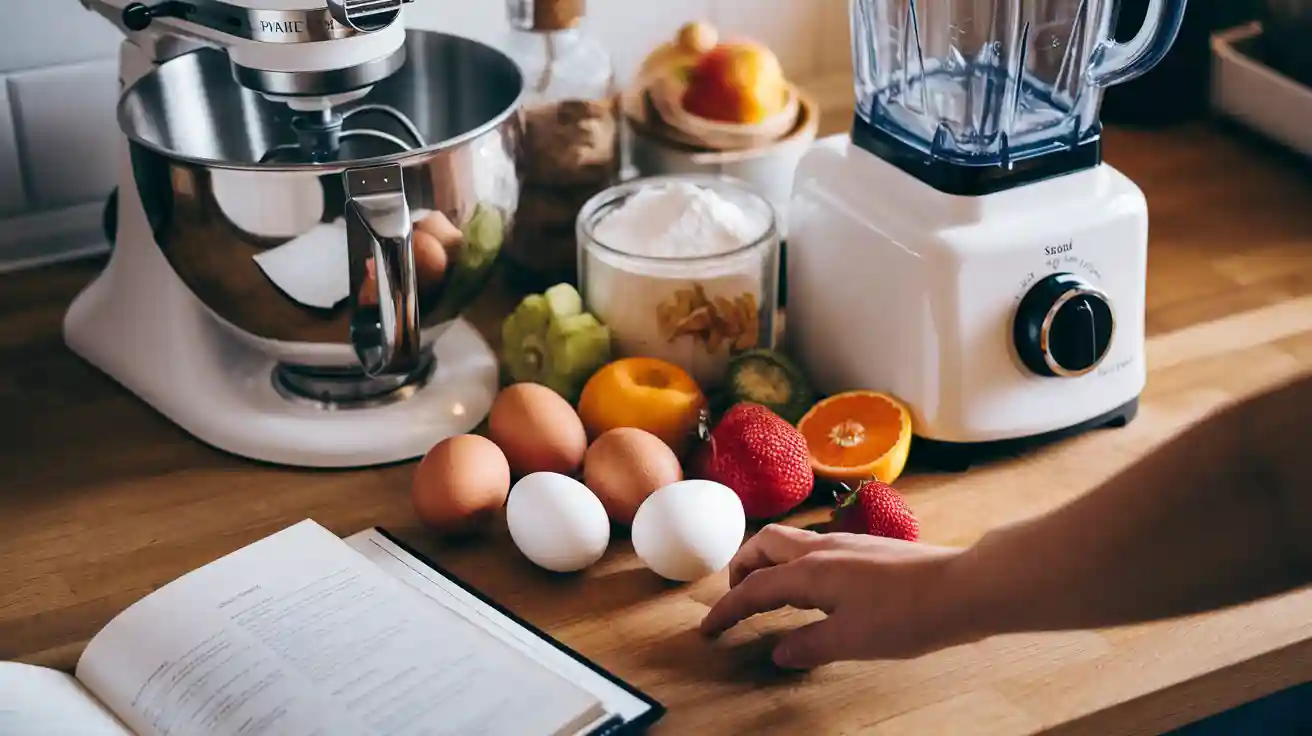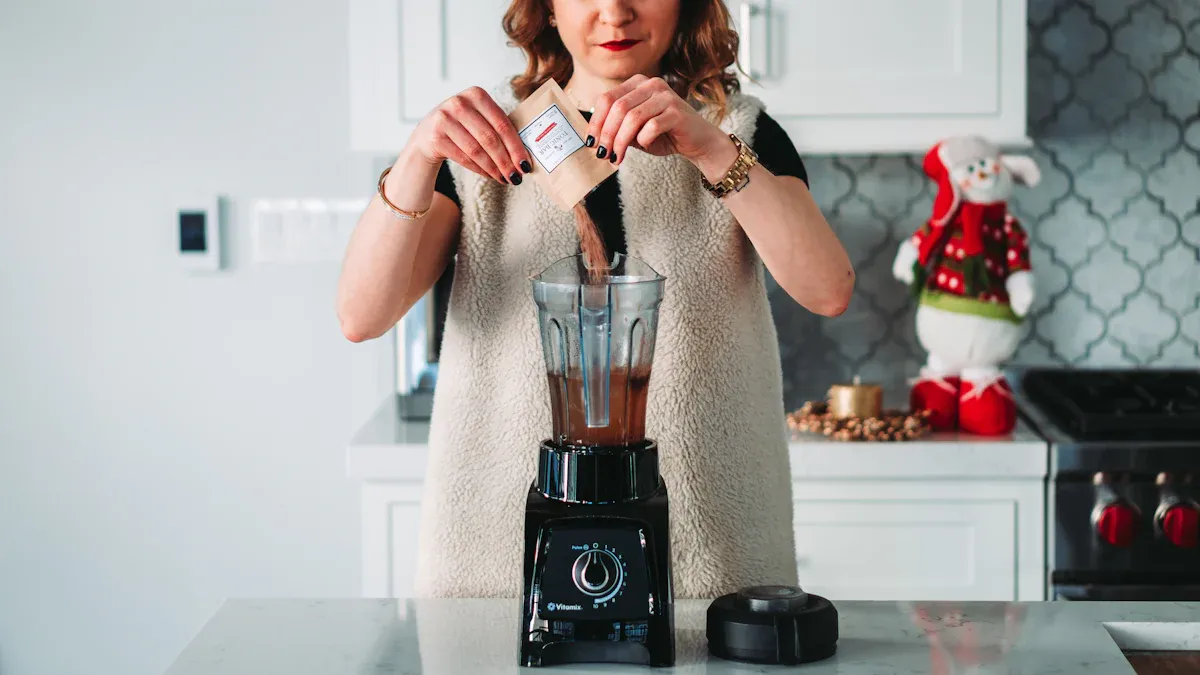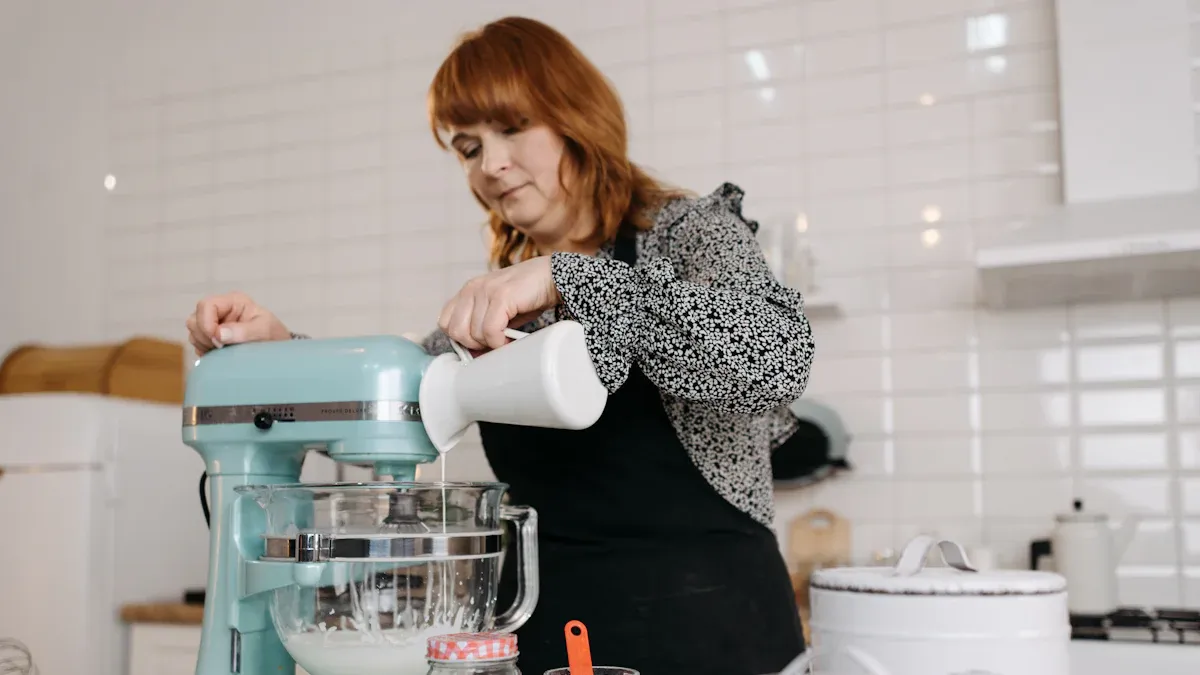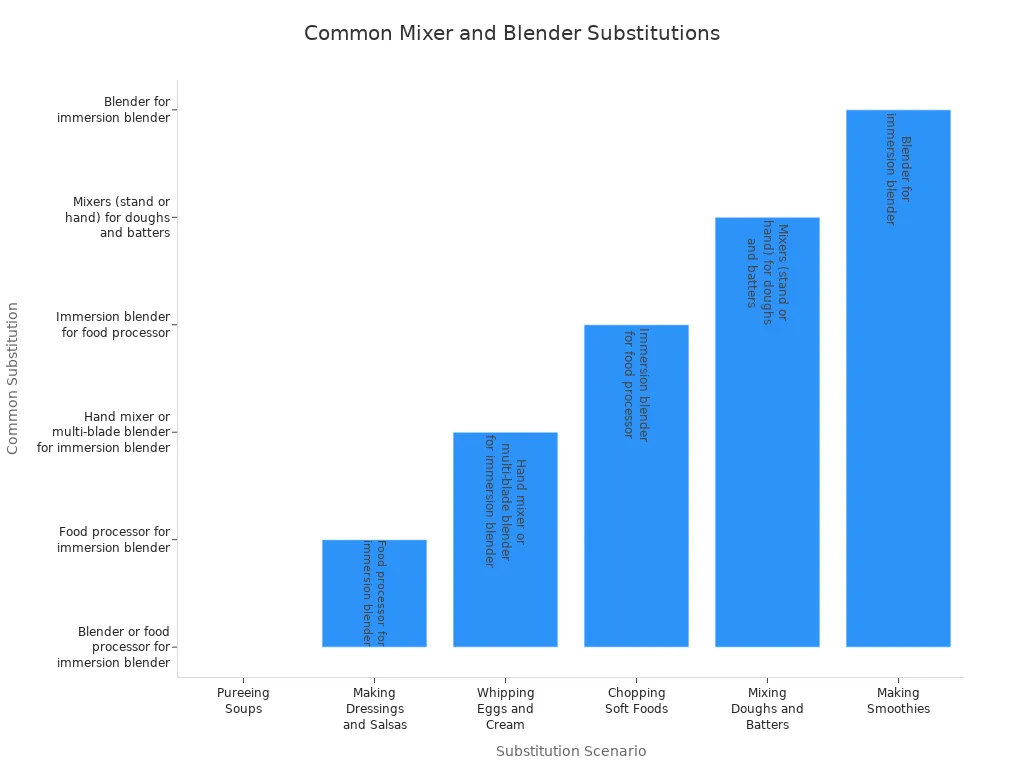
You often see food mixers and blenders in the kitchen, but they work differently. Use a mixer when you need to make dough or beat batters. Choose a blender for liquids or purees to get smooth results.
- People use food mixers and blenders for mixing, whisking, kneading, blending soups, and making smoothies.
Your recipe and the texture you want will help you decide which appliance to use.
Food Mixers and Blenders: What’s the Difference?
Food Mixer Overview
When you use a mixer, you handle tasks like beating, whisking, and kneading. A mixer helps you combine ingredients for doughs, batters, and thick mixtures. You often see a mixing bowl, a beater shaft, and different attachments like a flat beater, wire whip, or dough hook. Each part has a special job. For example, the dough hook kneads bread, while the wire whip beats egg whites for meringue. The mixer uses a planetary gear system to move attachments in a circular motion, so every part of your mixture gets mixed well.
Here is a table showing the main parts and their functions:
| Component | Function |
|---|---|
| Mixing Bowl and Handle | Holds ingredients for mixing |
| Beater Shaft | Rotates and holds mixing attachments |
| Flat Beater | Mixes batters and medium-to-heavy mixtures |
| Wire Whip | Whips cream and beats egg whites |
| Dough Hook | Kneads bread and pizza dough |
| Speed Control Lever | Lets you control mixing speed |
You use food mixers and blenders for different recipes, but a mixer works best for baked goods like cookies, cakes, and breads. Mixing with a mixer gives you control over texture and helps you get the right consistency for your recipe.
Blender Overview
A blender works best when you want to make smooth liquids or purees. You use a blender for soups, smoothies, sauces, and even nut butters. The blender has a powerful motor, sharp fixed blades, and a tall jar. The blades create a vortex that pulls ingredients down for even mixing. You need to add enough liquid for the blender to work well.
Blenders come with many features:
- Powerful motors (often over 1000 watts) for tough ingredients
- Variable speed settings and pulse functions for texture control
- Pre-programmed settings for smoothies, soups, and ice crushing
- Durable jars and safety features like locking lids
Culinary experts say you can use a blender for making silky soups, creamy sorbets, pancake batter, and even cocktails. Food mixers and blenders both help with mixing, but a blender gives you smooth, lump-free results for drinks and purees.
| Mechanical Aspect | Food Mixers | Blenders |
|---|---|---|
| Blade Design | Interchangeable beaters, whisks, dough hooks | Fixed blades angled upward |
| Mixing Style | Circular, planetary motion | Vortex for smooth blending |
| Liquid Requirement | Minimal | Needs enough liquid |
| Best For | Doughs, batters, thick mixtures | Smoothies, soups, purees, drinks |
Tip: Use food mixers and blenders together to expand your kitchen skills. Try a mixer for bread dough and a blender for a smoothie!
Types of Food Mixers and Blenders

Types of Food Mixers (Hand, Stand)
You can choose between two main types of mixer for your kitchen: hand mixers and stand mixers. A hand mixer is lightweight and easy to store. You hold it while mixing, which gives you more control for small tasks like whipping cream or beating eggs. Stand mixers are larger and sit on your counter. They have powerful motors and can handle heavy dough or large batches. You do not need to hold a stand mixer, so you can multitask while it works.
Here is a table to help you compare:
| Feature/Aspect | Hand Mixer | Stand Mixer |
|---|---|---|
| Portability | Easy to move and store | Needs counter space |
| Power | Less powerful | Strong motor for tough dough |
| Operation | Manual holding | Hands-free |
| Attachments | Fewer | Many (dough hook, pasta maker, etc.) |
| Price | Budget-friendly | More expensive |
| Cleaning | Simple | More parts to clean |
Tip: If you bake often or make bread, a stand mixer can save you time and effort.
Types of Blenders (Countertop, Immersion)
You will find two main types of blender: countertop blenders and immersion blenders. A countertop blender has a large jar and strong blades. It is the best blender for smoothies, soups, and crushing ice. You can use a high-powered blender for nut butters or frozen fruit. A high-quality blender can last for years and give you smooth results.
An immersion blender is a handheld tool. You use it directly in pots or bowls. You can blend soup right in the pot or make small batches of sauces. An immersion blender is easy to clean and store. You must handle it carefully because the blades are exposed. Some immersion blenders come with extra attachments like whisks or choppers.
Here are some advantages of each type:
- Countertop blender: large capacity, powerful, splash-free, very smooth results.
- Immersion blender: compact, easy to clean, blends directly in containers, quiet.
Note: An immersion blender is perfect for pureeing soup or making dressings quickly.
Blender vs Mixer: Key Differences

Function and Mechanism
When you compare a blender vs mixer, you notice big differences in how each appliance works. A mixer uses attachments like paddles, whisks, or dough hooks to combine, whip, or knead ingredients. You control the speed and choose the right attachment for your recipe. Mixers work at lower speeds and use gentle mechanical action. This helps you keep the texture of your dough or batter. You do not need much liquid for a mixer to work well.
A blender uses sharp, fast-spinning blades to create a vortex. The blades move at high speeds, sometimes up to 30,000 RPM. This action pulls ingredients down and breaks them into a smooth mixture. Blenders need enough liquid to blend ingredients properly. They work best for liquid-based ingredients and recipes that need a smooth texture.
Here is a table to help you see the main differences:
| Aspect | Mixer (Stand/Hand) | Blender (Countertop/Immersion) |
|---|---|---|
| Main Function | Mixing, whipping, kneading | Blending, pureeing, liquefying |
| Mechanical Action | Attachments rotate at low speeds | Blades spin at high speeds to create a vortex |
| Liquid Requirement | Minimal | Needs enough liquid to blend |
| Best For | Doughs, batters, whipped mixtures | Smoothies, soups, sauces, purees |
| Motor Speed (RPM) | Lower | Higher (up to 30,000 RPM) |
| Blade/Attachment Design | Paddles, whisks, dough hooks | Sharp, thick stainless steel blades |
Tip: Use a mixer for recipes that need air or structure, like bread or cake. Use a blender for recipes that need a smooth, even texture.
Texture and Results
The texture you get from a blender vs mixer can change your recipe. A mixer helps you make fluffy cakes, well-kneaded bread, and whipped cream. It adds air to your mixture and keeps the texture light or chewy, depending on what you want. You can mix thick dough or batter without turning it into a liquid.
A blender gives you a smooth, velvety texture. It works best for purees, smoothies, and soups. The high-speed blades break down ingredients until they are liquid. If you try to use a blender for dough, it will not work well. The dough will not rise or have the right texture. If you use a mixer for soup, you will not get a smooth puree.
Here is a table showing the textures each appliance produces:
| Appliance | Texture Produced | Typical Use Cases |
|---|---|---|
| Mixer | Fluffy, aerated, well-kneaded | Cakes, bread dough, whipped cream |
| Blender | Smooth, liquid, velvety | Smoothies, soups, sauces, purees |
- Blenders are best for liquid-based ingredients and recipes that need a silky finish.
- Mixers are best for recipes that need air or structure, like bread or cake.
Note: If you use the wrong appliance, your recipe may fail. For example, using a blender for bread dough can ruin the texture. Using a mixer for soup will not give you a smooth result.
Best Recipe Types
You should choose your appliance based on the recipe and the result you want. Mixers are perfect for recipes that need mixing, whipping, or kneading. You can make bread, pizza dough, cakes, cookies, and whipped cream with a mixer. The mixer keeps the texture fluffy or chewy and helps you get the right rise in baked goods.
Blenders are best for recipes that need a smooth, liquid texture. You can use a blender for smoothies, milkshakes, pureed soups, sauces, and baby food. The blender can also crush ice and blend frozen fruit for cold drinks. If your recipe has mostly liquid-based ingredients, a blender will give you the best results.
Here are some examples:
-
- Bread dough
- Cake batter
- Cookie dough
- Whipped cream
- Frosting
-
- Smoothies
- Pureed soups
- Sauces
- Milkshakes
- Fruit purees
Remember: Always check your recipe before you start. Using the right appliance helps you get the best texture and taste.
When to Use Food Mixers and Blenders
When to Use a Food Mixer
You reach for a mixer when you need power, control, and the ability to handle thick or heavy mixtures. Baking professionals recommend using a mixer for tasks that require thorough mixing or kneading. You can use a mixer for:
- Mixing cake batters for light, fluffy cakes
- Mixing cookie dough for even texture
- Kneading bread dough to develop gluten
- Whipping cream or egg whites for desserts
- Handling large batches of dough or batter
A mixer works best when you want to add air to your mixture or when you need to knead dough for bread or pizza. You can choose a stand mixer for big jobs or a hand mixer for smaller tasks. Stand mixers, like the KitchenAid Professional 600, offer extra power for kneading dough and mixing large amounts. If you bake bread often, you will appreciate the strength and stability of a stand mixer. You can also use a mixer with attachments for pasta or grinding meat.
| Baking Situation / User Need | Recommended Mixer Model | Reason / Features |
|---|---|---|
| Making dough for a 2lb bread loaf | KitchenAid Classic Plus | Additional power for kneading bread dough |
| Frequent large batches (10+ dozen cookies) | KitchenAid Professional 600 | Powerful motor and bowl-lift design for stability and capacity |
| Baking homemade bread frequently | KitchenAid Professional 600 | Designed for heavy doughs and large batches |
| Baking with a child | KitchenAid Artisan with glass bowl option | Glass bowl allows better visibility for learning and monitoring mixing |
Tip: If you want to save time and effort, use a mixer for kneading dough. You will get consistent results and less mess.
When to Use a Blender
You use a blender when you want to create smooth, liquid mixtures. Nutritionists suggest using a blender for making smoothies, purees, and sauces. A high-powered blender, such as a Vitamix or Ninja, can handle tough ingredients and give you a silky texture. You can use a blender for:
- Making smoothies with fruits, vegetables, and ice
- Blending soups until they are creamy
- Preparing purees for people who have trouble chewing or swallowing
- Mixing sauces like salsa or pesto
- Crushing ice for drinks
You can use an immersion blender for blending soups right in the pot or for making smoothies in a cup. Immersion blenders are easy to clean and store. You can also use them for small batches of sauces or dressings. Nutritionists recommend using a blender to combine whole foods and liquids for balanced nutrition. You can prepare and portion blended foods in advance and freeze them for convenience.
- Use a high-powered blender to avoid straining your mixtures.
- Rotate ingredients to keep your meals interesting and nutritious.
- Clean your blender and equipment after each use to prevent bacteria.
Note: Immersion blenders work well for pureeing soups and making smoothies quickly. You can blend directly in your cooking pot or mixing bowl.
Recipe Examples
You can choose the right appliance by looking at your recipe and the texture you want. Here are some examples:
-
Use a mixer for:
- Kneading dough for bread, pizza, or rolls
- Mixing cake or brownie batter
- Whipping cream for desserts
- Kneading dough for cinnamon rolls or bagels
- Mixing cookie dough for chocolate chip cookies
-
Use a blender for:
- Making smoothies with fruits, yogurt, and ice
- Blending soups like carrot or cauliflower until smooth
- Preparing salsa or creamy sauces
- Making smoothies for breakfast or snacks
- Creating purees for people who need soft foods
- Making smoothies with leafy greens and frozen fruit
- Using an immersion blender to blend soups, sauces, or smoothies right in the pot
- Making smoothies with protein powder and milk
- Using an immersion blender for quick smoothies or dressings
- Making smoothies with nut butters and seeds
- Using an immersion blender to puree vegetables for baby food
Callout: Immersion blenders are perfect for making smoothies, pureeing soups, and blending sauces. You can use them every day for quick, healthy meals.
You can see that mixers excel at kneading dough and mixing thick batters, while blenders and immersion blenders shine when making smoothies, purees, and sauces. If you love making smoothies or need to puree soups often, an immersion blender will become your favorite kitchen tool.
Can You Substitute a Blender for a Mixer (or Vice Versa)?
When Substitution Works
You can sometimes use a blender or an immersion blender instead of a mixer, especially for soft or liquid foods. For example, if you want to puree soup or make a smoothie, a blender works very well. Immersion blenders also help with small tasks like making vinaigrettes or chopping soft herbs. Some immersion blenders come with whisk attachments, which can whip cream or eggs in a pinch.
Here are some common successful substitutions:
| Substitution Scenario | Appliance Used as Substitute | Notes on Use and Outcome |
|---|---|---|
| Pureeing Soups | Blender or food processor | Work in small batches for best texture |
| Making Dressings and Salsas | Food processor instead of immersion blender | Results may be chunkier but taste remains similar |
| Whipping Eggs and Cream | Hand mixer or multi-blade blender | Hand mixer adds more air for fluffier results |
| Chopping Soft Foods | Immersion blender | Works well for soft foods like onions or potatoes |
| Mixing Doughs and Batters | Mixer (stand or hand) | Mixers handle doughs better than blenders |
| Making Smoothies | Blender instead of immersion blender | Blenders make smooth drinks quickly |

Tip: Use a blender for pureeing, chopping, or making drinks. Use a mixer for doughs, batters, and whipping.
Limitations and Risks
You should know that substituting a blender for a mixer does not always work, especially in baking. Blenders use sharp blades to chop and blend, but they do not add air to mixtures. Mixers use beaters or whisks to whip and aerate, which is important for recipes like cakes or whipped cream.
- If you use a blender instead of a mixer for cake batter, you get less air in the mix. Your cake may turn out dense and heavy.
- Immersion blenders can sometimes whip cream or eggs, but they work slower and do not make mixtures as fluffy as a hand mixer.
- Blenders cannot knead dough. The blades are not strong enough, and the dough will not rise well.
- Using a mixer for pureeing soups or making smoothies does not work. Mixers cannot break down solid foods into a smooth liquid.
Note: Always check your recipe. If it needs air or structure, use a mixer. If it needs to be smooth or liquid, use a blender. Using the wrong tool can change the taste and texture of your food.
Do You Need Both Food Mixers and Blenders in Your Kitchen?
Cooking Habits and Recipe Preferences
Your cooking habits shape which appliances you need. If you love baking bread, cakes, or cookies, a food mixer becomes essential for your kitchen. If you often make smoothies, soups, or sauces, a blender is just as essential. Think about your meal prep routine. Do you spend more time on baking or on blending fruits and vegetables? Some people find both appliances indispensable because they enjoy a wide range of recipes. You should also consider how much prep time you want to spend. Blenders require more prep, like peeling and removing seeds, while mixers focus on combining ingredients for doughs and batters.
- Ask yourself:
- Do you bake often?
- Do you make smoothies or purees regularly?
- Do you want to save time on meal prep?
Tip: If you enjoy both baking and blending, owning both appliances can make meal prep easier and more enjoyable.
Kitchen Space and Budget
Space and budget play a big role in your decision. Many kitchens have limited counter and storage space. You need to check if both appliances fit comfortably. Some people choose one essential appliance and use manual tools for other tasks. When planning your budget, look for quality and durability. Multi-use appliances can help you save space and money. Remember to think about cleaning and maintenance costs, too.
- Measure your kitchen space before buying.
- Set a budget for essential appliances.
- Choose energy-efficient models to save money over time.
- Plan for easy cleaning and warranty support.
Versatility and Convenience
Blenders offer more versatility for everyday cooking. You can use them for smoothies, soups, nut butters, and even hot liquids. High-powered blenders handle tough meal prep jobs. Some multifunctional appliances combine blender and food processor features, making them convenient for small kitchens. Food mixers focus on baking tasks, so they are essential if you bake often. For most meal prep, a blender covers more ground, but a mixer is still indispensable for baking fans.
| Appliance Type | Best For | Versatility Level |
|---|---|---|
| Blender | Smoothies, soups, sauces | High |
| Food Mixer | Doughs, batters, baking | Medium |
| Combo Appliance | Multiple tasks | Very High |
Note: If you want convenience and versatility in your kitchen, consider a multifunctional appliance for your meal prep needs.
You now know that blenders create smooth drinks and purees, while food mixers handle doughs and batters.
Checklist for choosing the right appliance:
- Think about your favorite recipes.
- Consider your kitchen space and style.
- Match the appliance to your cooking habits.
Choose what fits your needs best!
FAQ
Can you use a blender to knead bread dough?
You should not use a blender for bread dough. The blades cannot knead properly. You need a mixer for the right texture and rise.
What recipes work best with an immersion blender?
You can use an immersion blender for soups, sauces, and smoothies. It works well for pureeing cooked vegetables and blending liquids directly in pots or bowls.
How do you clean a stand mixer safely?
You should unplug the mixer first. Remove the attachments and bowl. Wash them with warm, soapy water. Wipe the mixer base with a damp cloth.


